MSI GE40 Review: a Slim Gaming Notebook
by Jarred Walton on July 16, 2013 3:00 AM ESTGreat Battery Life, LCD Sadness, Temperatures, and Noise
We wrap up our performance evaluation with a look at battery life and LCD quality, along with temperatures and noise. Here we get one winner and a few losers. It’s really unfortunate, as a better LCD could have warranted a reward of some form. We’ll start with the good news first, though: battery life is quite excellent, all told. Our Light, Medium, and Heavy battery life tests range from surfing the Internet to intense browsing while listening to music, with the Heavy test adding in a constant 1MBps download via local FTP with intense web surfing and 12Mbps 1080p H.264 playback. Gaming off the mains will be even more demanding, but otherwise the results below should represent a typical result as well as worst-case. The LCD was set for ~200 nits, which on the MSI GE40 ended up being 80% (two steps down).
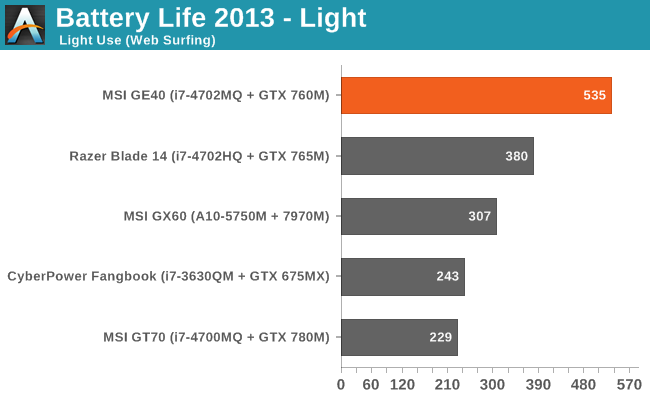
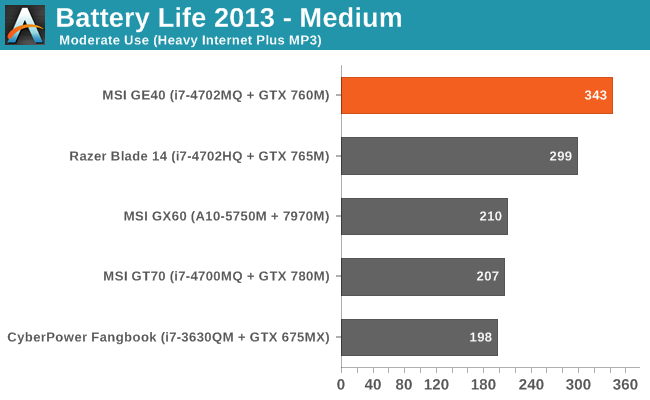
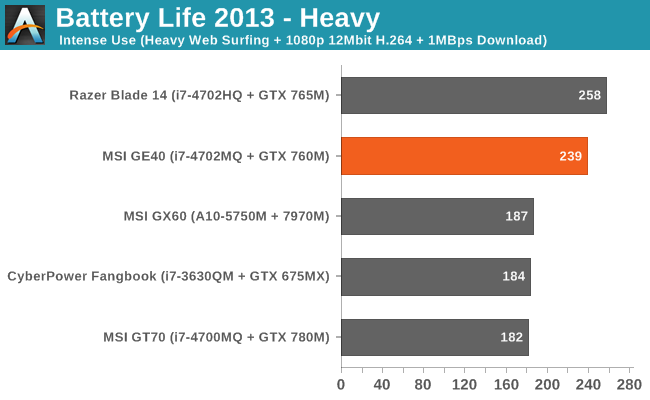

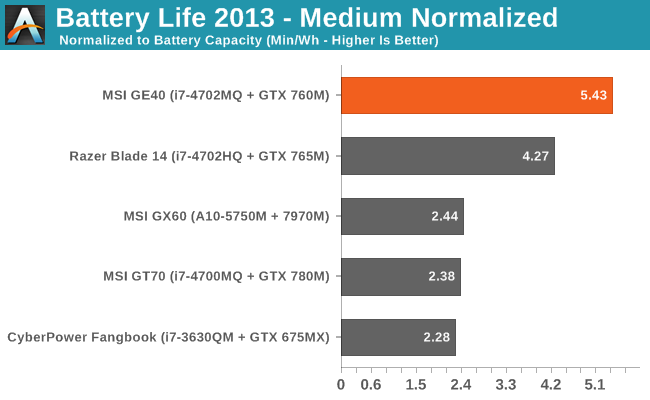
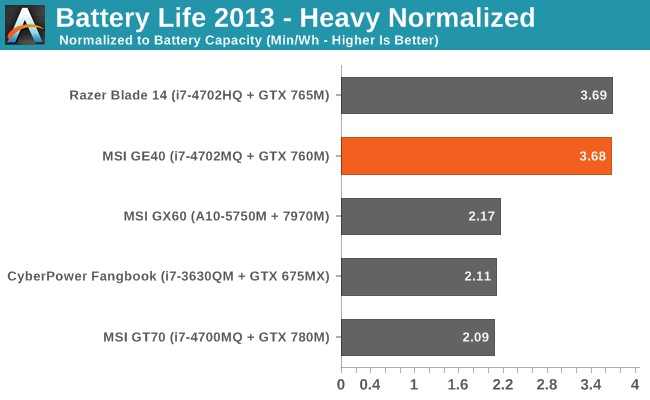
Haswell is a mobile-focused architecture, and it shows. It may not be much faster than Ivy Bridge in many cases, but seeing a viable gaming notebook pull off nearly nine hours of useful battery life is quite impressive. That drops quickly as you put a heavier load on the GE40, with around 5.75 hours of moderately heavy use and four hours of heavy use possible. If you just want to watch 1080p H.264 video, you can expect closer to five hours of battery life. Normalized battery life ends up equaling the Razer Blade in our heavy test while soundly trouncing all contenders in the light and medium tests.
But what about gaming on battery power? I ran a test as requested in the comments, and the results aren't particularly promising. First, battery life while gaming (running Skyrim) ended up at 104 minutes, still well short of the two hour mark. What's potentially worse is that even with all the settings tweaked for higher performance, NVIDIA's drivers (or MSI's BIOS/firmware) throttle GPU performance while on battery power. Plugged in Skyrim was running at a steady 60-70FPS, but once the power cord was unplugged it dropped down to 30-32FPS (with some dips into the low 20s on occasion). It looks like the notebook is shooting for 30FPS and no more when on battery power; I'll see if I can coax any better performance out of it in the morning, but even in the reduced performance mode you're still not going to be gaming for long while unplugged.
“What good were eyes to me? Nothing I could see could bring me joy.”
Perhaps that’s a bit too strong, but if you take the poor LCD from the Razer Blade 14 review and then limit the maximum brightness to 250 nits instead of 450 nits, you have the GE40’s LCD. Viewing angles are as bad as you’ll ever get with TN panels, and while it’s still possible to play games and not feel too bad, any photo editing is best done elsewhere. Here are the numbers:
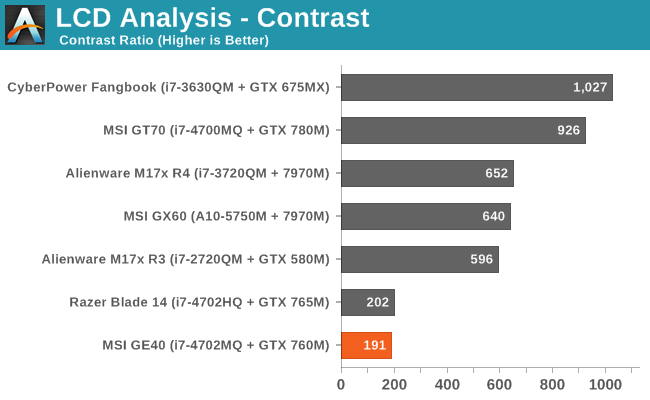
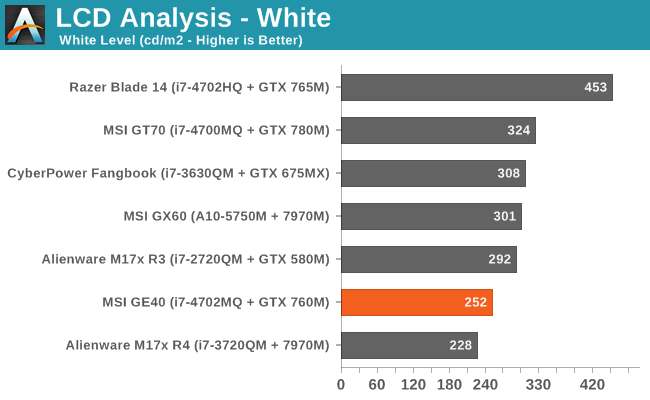
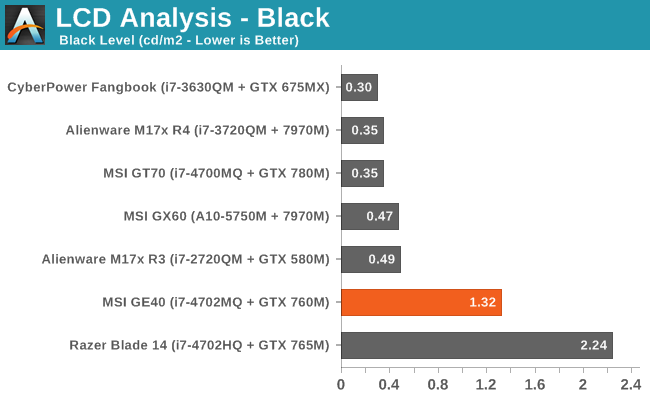
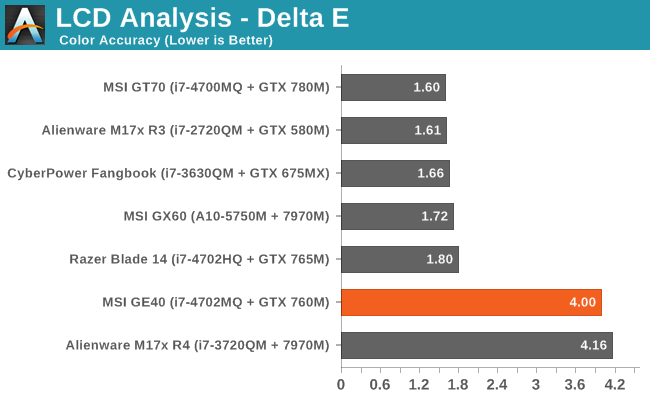

A contrast ratio below 200:1 is simply unacceptable in today’s market. This is the sort of display that will continue to drive users over to tablets. I do worry that something has gone wrong with my i1 Display2 colorimeter, as the DeltaE on the GE40 and M17x R4 are both much higher than I’d expect, so take those figures with a grain of salt until I can confirm my colorimeter is still working, but even if it’s off by a factor of two there’s nothing good to say. Average color accuracy without calibration is far worse, of course: I measured 17.4 average dE with the best result being 8.4 and the worst being 25.5—basically the same as what you see with many Android tablets I guess. Color gamut is also low, but really the contrast needs to be improved before we even worry about color gamut or accuracy.
Too Hot to Handle?
I ran some extended stress testing of the GE40, just to see what might happen. Under a full load, it took about ten minutes before the CPU and GPU had reached more or less equilibrium. It’s a bit warm here in WA right now, and I don’t have AC, so ambient temperatures were around 80-85F (27-29C), but even so the maximum CPU temperature of 98C is a concern. The GTX 760M didn’t have as much trouble, maxing out at a still-toasty-but-not-horrible 80C.
In practice, these figures aren’t even unusual; an extended session of Metro: Last Light looping our Value settings at 1600x900 hit 98C/84C on the CPU/GPU (average temps of 95.5C/81.4C), so the GPU actually got a bit hotter when the CPU wasn’t fully loaded. Idle temperatures at least are good, sitting around 46C/34C, and the surfaces of the GE40 for the most part are not too hot—one of the benefits of using plastic on the bottom of the chassis. The only real hot spot is on the left hand side near the exhaust, as you would expect. Still, the cooling is definitely pushing the limits of what we would deem “acceptable”—a year or two down the road when the cooling fins have a fine layer of dust and grime on them and we could easily be talking about an overheating notebook.
It’s Also Relatively Noisy
We haven’t had a lot of time with Haswell so far, so it’s difficult to say whether the temperatures in the upper 90s that we’re seeing under sustained load are normal or problematic. It’s very hard to get good thermals, high performance, and low noise levels in the same package, particularly if that package is less than an inch thick like the GE40. We’ve seen that thermals are definitely pushing the limit of what we’re comfortable with, but noise isn’t all that great either. At idle, we measured noise levels of 34.7dB while pretty much any reasonable gaming workload increased that to a maximum of 44.4dB; even under light loads (e.g. surfing the web), the fan will often spin up a bit to the 37dB range. Our full-load stress testing didn’t increase the noise, and even covering the exhaust with my hand didn’t create any additional noise (though that was mighty hot!), so the fan is basically topped out when gaming.










93 Comments
View All Comments
GuniGuGu - Tuesday, July 16, 2013 - link
Awesome review; Between this and the Razer Blade... only last portable gaming laptop to cover is the Clevo w230st :) Any plans jarred?GuniGuGu - Tuesday, July 16, 2013 - link
Also a big point of discussion for the Clevo w230st are the CPU options.. 4700, 4702, 4800 & 4900... It seems most on the forum are recommending the 4800.. but reading this it sounds like even the 4702 can get quite toasty....JarredWalton - Tuesday, July 16, 2013 - link
I think we'll be getting one in at some point in the next couple of weeks -- I'm heading out on vacation, so if Dustin doesn't get one before I return I'm sure I can find one. :-)GuniGuGu - Wednesday, July 17, 2013 - link
Damn, not sure I can wait that long before ordering it... Oh well, would love to see it run through the paces of an in-depth review all the same. Tossing up on the CPU's, the lower TDP of the 4702 is tempting over faster clocks.realjetavenger - Tuesday, July 16, 2013 - link
Actually, I'd also like to see the Alienware 14. This is a direct competitor to the Razer with what should be a much better lcd panel.mountcarlmore - Tuesday, July 16, 2013 - link
The Alienware is more than twice as thick and weighs over 6 pounds, its in a total different class from these latpops...noeldillabough - Tuesday, July 16, 2013 - link
True, but its in still in the running, I'd pick a thicker machine if it was noticeably faster.JarredWalton - Tuesday, July 16, 2013 - link
I don't expect it to be much faster at all -- we're still looking at i7-4700MQ with GTX 765M. With that CPU and GPU and a 256GB mSATA SSD + 750GB HDD, the cost is $1800. You also get a 1080p LCD. The display is really going to be the reason to go with the Alienware 14 I think, and to get that you'll have a heavier laptop that's twice as thick. On the other hand, I expect it will run cooler and quieter thanks to the size, but over six pounds means you can readily compare the AW14 to 15.6" options out there.The Clevo W350ST is a 15.6" laptop with similar dimensions to the AW14, and with similar components it can be had for around $1500. Not that I expect the Clevo W350ST to be built better than the AW14, but the dimensions are 14.72" x 9.84" x 0.64"~1.68" and it weighs 5.95 pounds where the 14" AW measures 13.31" x 10.17" x 1.58"~1.64" and weighs 6.12 lbs. So the Clevo is wider but not as deep and has more of a wedge shape, and it weighs a bit less.
Anyway, we're definitely going to see about reviewing the Alienware 14 and 17 as soon as we can.
hfm - Wednesday, July 17, 2013 - link
From all the reviews and user commentary I've read, the Alienware 14 is definitely not exactly "cool and quiet" some users have complained about how loud it is. Also, be prepared for the Alienware 14 to play games at lower frame rates than the Razer due to 33% more pixels at native resolution.Bob Todd - Wednesday, July 17, 2013 - link
"Cool and quiet" with these kinds of specs in a reasonably portable machine doesn't really seem possible with the current crop of CPUs/GPUs. Do you want quiet or do you want adequate cooling? I'm not really comfortable at all with a brand new machine hitting 98 degrees Celsius under load, or even the 93 degrees the Blade hit. I'll deal with a louder fan if it means I don't have to worry as much about throttling (or heat induced crashes). Especially on a gaming focused machine where I'd have the sound cranked up a bit or headphones in while using it the way it was intended.